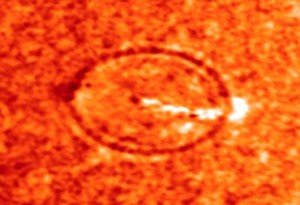
Allies and the bloated community
We continue to comment on Spheres I of Sloterdijk in his introduction.
Explaining the bubble influx, Sloterdijk begins to develop his analysis of modernity from the genesis, exploring the Copernican model that is at its origin, to affirm that it is not by chance that “a series of exploratory ruptures have begun, aimed at an exterior devoid of human beings … “(Sloterdijk, 2016, 22), but which did not cease to” produce discomfort as the infinity of the universe “(idem) reflection of the astrophysicist Kepler, protesting the model of Giordano Bruno “there is a non-know -that of terrifying and hidden. “
The image of an explosion on the surface of the Sun, larger than Earth illustrates this passage.
The author also quotes the English physicist and cosmographer Thomas Digges, who in the 1570s had already proved that the theory of the celestial layers was unfounded and “also the calculating image that the Earth was surrounded by spherical vaults” (page 23) Was wrong, but as I said in Pascal’s phrase: “the eternal silence of infinite spaces terrifies me,” and the machinic and rationally explained world was advantageous to the Enlightenment.
It then develops the deliberate greenhouse effect, where its “lack of space wrappings through a civilized artificial world … this is the ultimate horizon of Euro-American technical titanism” (page 25).
After criticizing the policies of progress and ecological destruction, he writes: “In order to make room for the substitute artificial sphere, the remains of a faith in the inner world and in the fiction of a security are exploded in all regions of the old world. The name of a radical market enlightenment that promises a better life, but which, in a first moment, only devastates the immune norms of the proletariat and the peripheral populations “(page 27).
He emphasizes the importance of the ontological resumption and that this is the concern of more contemporary philosophers: “The popular plan of forgetting oneself and the Being operates through a mocking disregard for the ontological situation” (page 28).
Before turning to criticism of idealism and a rereading of Christianity, he points out on page 29 what is the center of the book: “As dwelling always means to constitute spheres, smaller or greater, men are creatures who establish circular worlds and look on Direction to the exterior to the horizon. “
SLOTERDIJK, Peter. Spheres I: bubbles. São Paulo: Estação Liberdade, 2016









